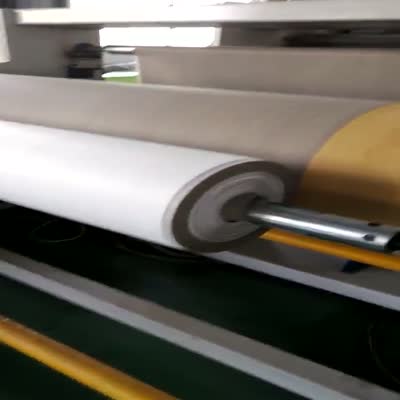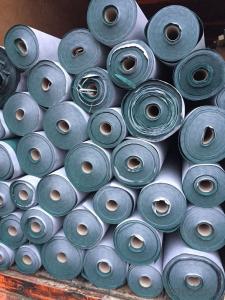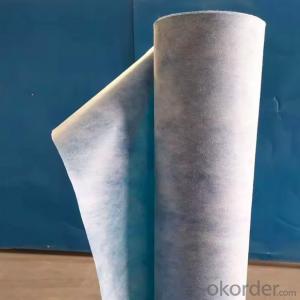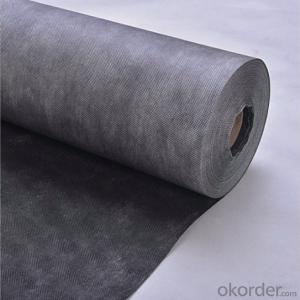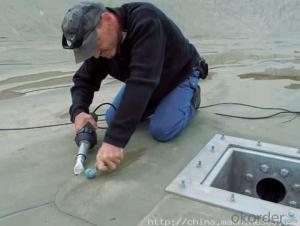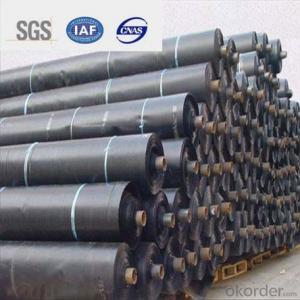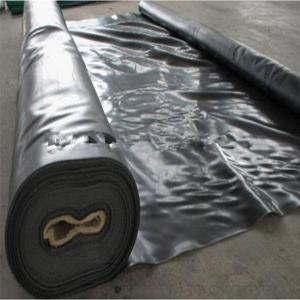Breathable Membrane 1m x 50m or 1.5m x 50m Roofing Felt Roll UNDER TILE
- Loading Port:
- SHANGHAI
- Payment Terms:
- TT OR LC
- Min Order Qty:
- 500 m²
- Supply Capability:
- 100000 m²/month
OKorder Service Pledge
OKorder Financial Service
You Might Also Like
Specification
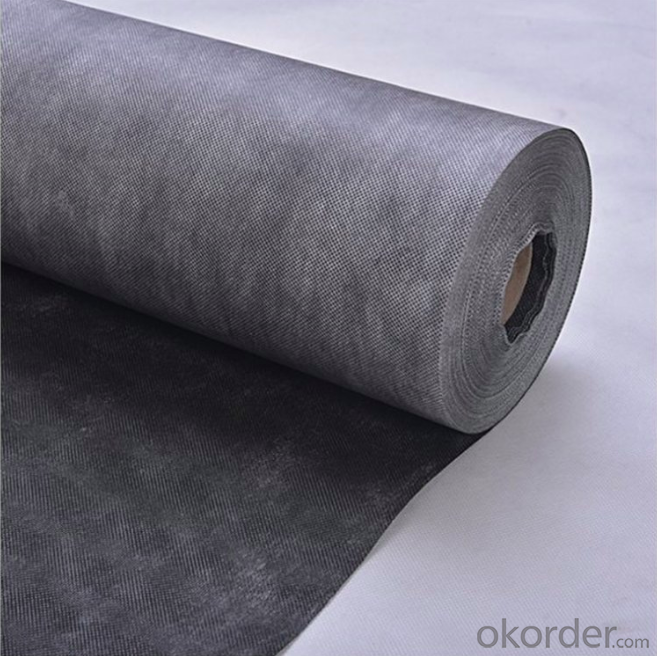
Product Feature:
Air open & vapour permeable
More breathable than any other 'air open' underlay on the market
Lowest vapour resistance of all breathable membranes
Being both air open & vapour permeable further minimises the risk of condensation forming
No ventilation required
Strong 3 layer material
Superior nail tear strength
| Mass per unit area: | 140g/m2 |
| Product Type: | Waterproofing Breathable Bembrane For House Wrapping |
| Material: | PP/PE granule |
| Tensile Strength(MD/XD): | 190N/5cm(+-20%)/150N/5cm(+-20%) |
| Resistance to tearing(MD/XD): | >50N/50N |
| Flexibility at low temperature: | (-)24°C |
| Resistance to water pentration: | W1 |
| Temperature resistance | (+)70°C |
| Resistance to UV | 3momths |
| Loading quantity | 40' HC ---2000rolls |
Our company :
our company is a leading professional manufacturer in China, which locates in Yangzhou State-grade Development Zone,Yangzhou City, Jiangsu Province, nearby Shanghai.
We have advanced production lines with the technology from Italy and Germany, which are applied to nonwoven products, film lamination, roofing materials, disposable medical products, packaging materials and so on.Main products:Nonwoven fabric , SMS, SMMS and manufactured productsFilm or foil laminated products Roofing membrane, flooring underlayPE woven fabric, PE tarpaulin, vapor barrierGreenhouseWe not only have first-class processing line, but have first-grade quality management. We have been qualified by ISO9001 (quality) and CE, this system can supply active way to guarantee the quality. We have exported to many countries, such as Canada, USA, Chile, Argentina, New Zealand, Australia, Malaysia, Japan, Ukraine, Latvia, Slovenia, Slovakia, Spain, CZ, Russia, Croatia, Bulgaria, Romania, Italy, UK, Germany, Greece and so on. With a group of excellent senior management and hi-tech R& D personnel and our skilled workers, we can supply you the goods with competitive prices and better quality. We look forward to establish friendly and long term relationship with you in the near future.
FAQ:
1. who are we?
We are based in Jiangsu, China, start from 2008,sell to Eastern Europe(18.00%),Southern Europe(15.00%),Northern Europe(15.00%),Western Europe(12.00%),South Asia(6.00%),Eastern Asia(5.00%),Oceania(5.00%),Central America(5.00%),Southeast Asia(5.00%),North America(3.00%),South America(3.00%),Africa(3.00%),Domestic Market(3.00%),Mid East(2.00%). There are total about 11-50 people in our office.
2. how can we guarantee quality?
Always a pre-production sample before mass production;
Always final Inspection before shipment;
3.what can you buy from us?
Breathable Membrane, Reflection Breathable Membrane, Housewrap, Vapor Barrier, Heat Insulation Film
4. why should you buy from us not from other suppliers?
We not only have first-class processing line, but have first-grade quality management. We have been qualified by ISO9001 (quality) and CE, this system can supply active way to guarantee the quality. We have exported to many countries, such as Canada, USA,
5. what services can we provide?
Accepted Delivery Terms: FOB,CFR,CIF,EXW;
Accepted Payment Currency:USD,EUR,JPY,CAD,HKD,CNY;
Accepted Payment Type: T/T,L/C,Credit Card,PayPal,Western Union,Cash;
- Q: What are the benefits of using a waterproofing membrane?
- The benefits of using a waterproofing membrane include protecting the structure from water damage, preventing leaks and seepage, extending the lifespan of the building, reducing maintenance and repair costs, and creating a healthier and more comfortable environment by preventing mold and mildew growth.
- Q: Can a waterproofing membrane be used for a balcony deck coating?
- Yes, a waterproofing membrane can be used for a balcony deck coating. Waterproofing membranes are designed to create a protective barrier that prevents water penetration, making them an ideal choice for balcony decks. By applying a waterproofing membrane to the deck surface, you can prevent water damage, such as leaks, cracks, and deterioration, which can lead to costly repairs. Additionally, waterproofing membranes can also protect the underlying structure of the balcony from moisture damage, extending its lifespan. It is important to choose a high-quality waterproofing membrane that is specifically designed for outdoor use and can withstand exposure to harsh weather conditions.
- Q: Can a waterproofing membrane be used in permanent or long-term structures?
- Yes, a waterproofing membrane can be used in permanent or long-term structures. Waterproofing membranes are designed to provide durable and long-lasting protection against water intrusion. They are commonly used in various construction applications such as basements, roofs, foundations, and underground structures to prevent water damage and leakage. These membranes are engineered to withstand the test of time and can effectively extend the lifespan of a structure by ensuring its integrity and preventing moisture-related issues.
- Q: 3MM thick, one square meter waterproof membrane SBS price?
- 4, SBS modified asphalt waterproofing membrane is SBS rubber modified petroleum asphalt cited as the invasion coating, polyester fiber non-woven fabrics, jute cloth, fiberglass mats were made for the fetal base, to plastic film for the defense Sticky isolation layer, by the selection, ingredients, eutectic, invasion, composite molding, curling and other processes processing production.
- Q: Are there any specific safety precautions to consider when installing a waterproofing membrane?
- Yes, there are several safety precautions to consider when installing a waterproofing membrane. Firstly, it is important to ensure that all necessary personal protective equipment (PPE) is used by the installation team. This may include gloves, safety glasses, and appropriate footwear to prevent any injuries or exposure to hazardous materials. Additionally, it is crucial to work in a well-ventilated area to avoid inhalation of fumes or vapors emitted during the installation process. If working in a confined space, proper measures should be taken to ensure adequate ventilation and the use of proper respiratory protection if necessary. Furthermore, it is important to follow the manufacturer's instructions and guidelines for the specific waterproofing membrane being installed. This includes understanding any potential hazards associated with the product, such as flammability or toxicity, and taking necessary precautions to prevent accidents or exposure. Another safety consideration is to ensure that the installation area is properly prepared before beginning the process. This may involve removing any debris, cleaning the surface, and addressing any potential hazards or obstacles that could pose a risk to the installation team. Lastly, it is important to have a designated safety plan in place, including emergency procedures and first aid kits readily available in case of accidents or injuries. Regular safety inspections and monitoring throughout the installation process are also recommended to identify and address any potential safety risks promptly. By following these safety precautions, the installation of a waterproofing membrane can be carried out safely and effectively, minimizing the risk of accidents or injuries.
- Q: Can waterproofing membranes be applied in cold weather?
- Yes, waterproofing membranes can be applied in cold weather. However, it is important to ensure that the manufacturer's instructions are followed regarding temperature limitations and proper installation techniques. Cold weather may affect the curing and adhesion process, so additional precautions and proper heating or insulation methods may be necessary during the application.
- Q: Can a waterproofing membrane be used in hot climates?
- Yes, a waterproofing membrane can be used in hot climates. In fact, it is essential to use a waterproofing membrane in areas with high temperatures and intense sunlight. The membrane provides protection against water intrusion, which is crucial in preventing damage to structures such as roofs, balconies, or basements. Additionally, a high-quality waterproofing membrane is designed to withstand the effects of temperature fluctuations and UV radiation, ensuring its longevity and effectiveness even in hot climates. Therefore, using a waterproofing membrane is highly recommended in hot climates to ensure the durability and integrity of the structures it is applied to.
- Q: Can waterproofing membranes be used on stormwater management systems?
- Indeed, stormwater management systems can benefit from the application of waterproofing membranes. These membranes are frequently utilized to safeguard structures against water infiltration and potential water-related harm. In the case of stormwater management systems, which are designed to collect, retain, and efficiently handle rainwater runoff, waterproofing membranes can be employed to establish a completely watertight seal, thereby averting leaks and seepage. Stormwater management systems often incorporate various components, such as retention ponds, infiltration basins, or underground storage systems. These elements must be adequately sealed to ensure the proper containment and effective management of the collected stormwater. When properly installed, waterproofing membranes serve as an impermeable barrier, effectively preventing water from escaping or infiltrating the system. The utilization of waterproofing membranes on stormwater management systems offers numerous advantages. Firstly, it helps to maintain the system's integrity and functionality by preventing leaks or seepage that could compromise its performance. This ensures that the stormwater is efficiently captured and managed, minimizing the risk of flooding or erosion. Furthermore, waterproofing membranes can significantly prolong the lifespan of stormwater management systems by safeguarding them against water damage. Water infiltration can lead to structural degradation, corrosion, or the proliferation of mold and mildew, all of which weaken the system over time. By establishing a waterproof barrier, these membranes contribute to the preservation of the structural integrity of the components, thus increasing their longevity and reducing maintenance requirements. Moreover, the use of waterproofing membranes on stormwater management systems also contributes to environmental sustainability. By effectively containing and managing stormwater runoff, these systems aid in reducing water pollution and enhancing the quality of natural water bodies. Waterproofing membranes play a vital role in preventing stormwater from carrying pollutants, such as chemicals or sediment, into rivers, lakes, or oceans. In conclusion, waterproofing membranes can be effectively utilized on stormwater management systems to establish a watertight seal, prevent leaks, and protect the components from water damage. By providing an impermeable barrier, these membranes help to maintain the system's functionality and integrity, prolong its lifespan, and contribute to environmental sustainability by reducing water pollution.
- Q: Can waterproofing membranes be used in wet areas like bathrooms?
- Yes, waterproofing membranes can indeed be used in wet areas like bathrooms. In fact, it is highly recommended to use waterproofing membranes in bathroom areas to prevent water damage and leakage. These membranes are specifically designed to create a barrier against moisture, ensuring that water does not seep through the walls, floors, or other surfaces of the bathroom. By applying a waterproofing membrane, you can effectively protect the underlying structure from water damage, mold growth, and other issues caused by prolonged exposure to moisture. This is especially important in wet areas like bathrooms where water is constantly present. Waterproofing membranes are available in various forms such as sheet membranes, liquid membranes, and even pre-formed shower trays. They can be applied to walls, floors, shower enclosures, and other surfaces to create a watertight seal. It is crucial to properly install and maintain the waterproofing membrane as per manufacturer guidelines to ensure its effectiveness and longevity. Therefore, if you are considering renovating or building a bathroom, using waterproofing membranes is highly recommended to ensure a durable and moisture-resistant space.
- Q: How thick is a typical waterproofing membrane?
- A typical waterproofing membrane is usually between 1 to 2 millimeters thick.
Send your message to us
Breathable Membrane 1m x 50m or 1.5m x 50m Roofing Felt Roll UNDER TILE
- Loading Port:
- SHANGHAI
- Payment Terms:
- TT OR LC
- Min Order Qty:
- 500 m²
- Supply Capability:
- 100000 m²/month
OKorder Service Pledge
OKorder Financial Service
Similar products
Hot products
Hot Searches
Related keywords
